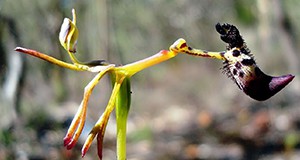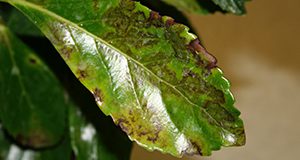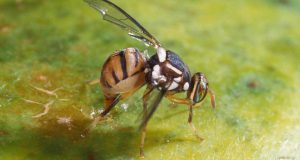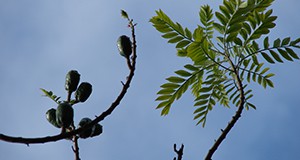This new 5-page document introduces the sources, providers, and types of rainfall data available to Florida researchers and residents to promote understanding of the rainfall data and their application in studies and daily life. Written by Meijing Zhang, Young Gu Her, Kati Migliaccio, and Clyde Fraisse, and published by the UF Department of Agricultural and Biological Engineering, January 2017.
http://edis.ifas.ufl.edu/ae517
Tag: Tropical REC
Viburnum Downy Mildew
Downy mildew on viburnum is currently a serious concern throughout Florida. Winters in south Florida combine high humidity with cool nights, creating ideal conditions for disease development. Downy mildews are caused by several different species that tend to be host specific. Plasmopara vibruni is the pathogen that affects viburnum. This five-page fact sheet describes the hosts, symptoms, and management practices for Viburnum Downy Mildew.
Written by A. J. Palmateer and published by the Plant Pathology Department.
http://edis.ifas.ufl.edu/pp329
Estimated Costs and Regional Economic Impacts of the Oriental Fruit Fly (Bactrocera dorsalis) Outbreak in Miami-Dade County, Florida
Oriental fruit flies, very destructive pests of fruits, were first detected in the Redland area of Miami-Dade County on August 26, 2015, and as of January 2016, 165 flies had been captured. This triggered an eradication program and establishment of a quarantine area composed of agricultural operations and nonagricultural properties, such as residential and commercial areas. As part of the effort to eradicate the fruit fly, growers and packers in the quarantine area are required to sign a compliance agreement that outlines the procedures necessary for harvesting, handling, and postharvest processing of agricultural products that may serve as hosts for any life cycle of the fruit fly. This 12-page fact sheet written by Sergio Alvarez, Edward A. Evans, and Alan W. Hodges and published by the UF Food and Resource Economics Department provides estimates of the direct and indirect losses to Florida’s agriculture and related sectors as a result of the outbreak and ensuing quarantine and eradication programs.
http://edis.ifas.ufl.edu/fe988
Ocho Pasos para Desarrollar un Plan Simple de Mercadeo

El mercadeo es parte esencial de un negocio. De hecho es el corazón de cualquier negocio que sirva la función vital de convertir actividades de producción en desempeño financiero, asegurando la supervivencia del negocio. El mercadeo es clave, sin importar el tipo de negocio (incluyendo la agricultura).
This 5-page fact sheet provides a rationale for developing a marketing plan, a step-by-step process for creating one, and a marketing plan worksheet. Written by Edward A. Evans and Fredy H. Ballen, and published by the UF Department of Food and Resource Economics. Translated into Spanish November 2015. (Photo credit: Thinkstock)
http://edis.ifas.ufl.edu/fe978
(also available in English as “Eight Steps to Developing a Simple Marketing Plan” at http://edis.ifas.ufl.edu/fe967)
Eight Steps to Developing a Simple Marketing Plan

Marketing is an essential component of any business, including agriculture. Despite the important role of marketing, many smallholding operators/growers are reluctant to create a marketing plan. This 5-page fact sheet provides a rationale for developing a marketing plan, a step-by-step process for creating one, and a marketing plan worksheet. Written by Edward A. Evans and Fredy H. Ballen, and published by the UF Department of Food and Resource Economics, August 2015. (Photo credit: iStock/Thinkstock)
http://edis.ifas.ufl.edu/fe967
Orchid Pollination Biology

Orchids and their pollinators have developed fascinating co-adaptations that promote orchid pollination. This 6-page fact sheet details the various and often strange ways that orchids attract pollinators. The kinds of insects and animals that pollinate orchids and orchids’ reproductive anatomies and processes are also covered. Written by Haleigh Ray and Wagner Vendrame, and published by the UF Department of Environmental Horticulture, June 2015.
http://edis.ifas.ufl.edu/ep521
Spondias Growing in the Florida Home Landscape
Spondias species (whose common names among English speakers include ambarella, Ataheite apple, mombins, and hog plums) are flowering trees native to tropical and subtropical regions. They are known for their sweet fruit and grow well in the warmest parts of Florida. This 8-page fact sheet discusses biology, distribution and uses, as well as guidelines for propagation and maintenance. Written by Jonathan H. Crane and Jeffrey Wasielewski, and published by the UF Department of Horticultural Sciences, April 2015. (Photo by Forest & Kim Starr, CC BY 3.0)
http://edis.ifas.ufl.edu/mg059
Smartirrigation Apps: Urban Turf
 We developed an app called Smartirrigation Turf to provide an easy-to-use mobile tool that delivers information to improve irrigation scheduling for urban turf. Using the app instead of a set time-based schedule for irrigation, homeowners and others can provide irrigation amounts to turf that more closely match water needs. This version of the app is applicable in Florida and Georgia and is available to download in the Apple App Store and Google Play Store. This 5-page fact sheet was written by K. W. Migliaccio, J. H. Debastiani Andreis, C. Fraisse, K. T. Morgan, and G. Vellidis, and published by the UF Department of Agricultural and Biological Engineering, October 2013.
We developed an app called Smartirrigation Turf to provide an easy-to-use mobile tool that delivers information to improve irrigation scheduling for urban turf. Using the app instead of a set time-based schedule for irrigation, homeowners and others can provide irrigation amounts to turf that more closely match water needs. This version of the app is applicable in Florida and Georgia and is available to download in the Apple App Store and Google Play Store. This 5-page fact sheet was written by K. W. Migliaccio, J. H. Debastiani Andreis, C. Fraisse, K. T. Morgan, and G. Vellidis, and published by the UF Department of Agricultural and Biological Engineering, October 2013.
http://edis.ifas.ufl.edu/ae499
Tomato Chlorotic Spot Virus
 Tomato chlorotic spot virus (TCSV) is a tospovirus, similar to but distinct from other tospoviruses currently present in Florida. Like these viruses, TCSV is transmitted by thrips and is able to replicate in both the vector and the plant. TCSV was first reported in Florida in 2012 in tomato plants in Miami-Dade and Lee Counties, but it may have been in the state for several years. Prior to 2012, TCSV was only known to occur in Brazil and Argentina. It is not known how this virus was introduced into Florida. This 5-page fact sheet was written by Jane E. Polston, Erin Wood, Aaron J. Palmateer, and Shouan Zhang, and published by the UF Department of Plant Pathology, May 2013.
Tomato chlorotic spot virus (TCSV) is a tospovirus, similar to but distinct from other tospoviruses currently present in Florida. Like these viruses, TCSV is transmitted by thrips and is able to replicate in both the vector and the plant. TCSV was first reported in Florida in 2012 in tomato plants in Miami-Dade and Lee Counties, but it may have been in the state for several years. Prior to 2012, TCSV was only known to occur in Brazil and Argentina. It is not known how this virus was introduced into Florida. This 5-page fact sheet was written by Jane E. Polston, Erin Wood, Aaron J. Palmateer, and Shouan Zhang, and published by the UF Department of Plant Pathology, May 2013.
http://edis.ifas.ufl.edu/pp306
Well Installation Procedures for Agricultural Irrigation in Miami-Dade County (AE489)
 Water wells or groundwater wells are the main source of irrigation water for agriculture in Miami-Dade County. Depending on the purpose and characteristics of the well, different permits are required for installing the well and pumping water from the well. The information provided in this 4-page fact sheet is based on current rules, contacts, and prices as of March 2012 for Miami-Dade County. Written by Kati W. Migliaccio, E. Vanessa Campoverde, and Ann Marie Superchi, and published by the UF Department of Agricultural and Biological Engineering, June 2012.
Water wells or groundwater wells are the main source of irrigation water for agriculture in Miami-Dade County. Depending on the purpose and characteristics of the well, different permits are required for installing the well and pumping water from the well. The information provided in this 4-page fact sheet is based on current rules, contacts, and prices as of March 2012 for Miami-Dade County. Written by Kati W. Migliaccio, E. Vanessa Campoverde, and Ann Marie Superchi, and published by the UF Department of Agricultural and Biological Engineering, June 2012.
http://edis.ifas.ufl.edu/ae489
Management of Orchid Pests with Silwet® L-77 and Horticultural Oils (PP287)
 IFAS researchers evaluated the ability of the surfactant Silwet® L-77 to improve the efficacy of horticultural oils in controlling boisduval scale and mite infestations in orchids. This 3-page fact sheet reports the results and provides homeowners with directions for its use. Written by R. A. Cating, M. A. Hoy, and A. J. Palmateer, and published by the UF Department of Plant Pathology, November 2011.
IFAS researchers evaluated the ability of the surfactant Silwet® L-77 to improve the efficacy of horticultural oils in controlling boisduval scale and mite infestations in orchids. This 3-page fact sheet reports the results and provides homeowners with directions for its use. Written by R. A. Cating, M. A. Hoy, and A. J. Palmateer, and published by the UF Department of Plant Pathology, November 2011.
http://edis.ifas.ufl.edu/pp287
Branch Dieback of Syzygium paniculatum (Eugenia) (PP283)

Eugenia’s popularity stems from its dense, attractive foliage, the ease with which the canopy can be sculpted, and its relatively carefree management. But shortly after Hurricane Wilma in November 2005, a serious dieback disease began to affect nursery production of eugenia in the Homestead area. Since then, the disease has become prevalent, affecting local nurseries throughout South Florida. Learn more about this disease and its management in this 4-page fact sheet written by A. J. Palmateer and T. L. B. Tarnowski, and published by the UF Department of Plant Pathology, July 2011.
http://edis.ifas.ufl.edu/pp283
Sustainability of Agriculture in Miami-Dade County: Considering Water Supply (ABE380/AE429)
Developing sustainable agricultural practices in Miami-Dade County (Figure 1) is important to ensuring the future of its economically significant winter vegetable, tropical fruit, and ornamental nursery plant production. This 8-page fact sheet discusses water availability, factors that influence water availability, agricultural water use, and irrigation efficiency as they relate to Miami-Dade County. It was written by Kati W. Migliaccio and published by the UF Department of Agricultural and Biological Engineering, January 2011.
http://edis.ifas.ufl.edu/ae429
Evolution of water quality regulations in the United States and Florida (AE431)
Water is essential to sustain life. Not only do we all need a certain quantity of water each day, but the quality of the available water is also critical. Water quality protection in the United States evolved from initially ensuring navigability of waterways to protecting our natural ecosystems. This 5-page fact sheet provides a background for understanding water quality and how it is evaluated and regulated in the U.S. with particular focus on the state of Florida. Written by Kati W. Migliaccio, Yuncong Li, and Thomas A. Obreza. Published by the UF Department of Agricultural and Biological Engineering, January 2011.
http://edis.ifas.ufl.edu/ae431
FC47/CH092 Key Lime Growing in the Florida Home Landscape
Revised! FC47, a 12-page fact sheet by Jonathan Crane, provides homeowners with an overview of this small bushy citrus fruit tree introduced to the Americas by Spanish and Portuguese explorers in the sixteenth century — description, propagation, fruit production, placement in the landscape, care, pest management, concerns with lawn care, harvest, ripening, and storage, use and nutrition. Includes references. Published by the UF Department of Horticultural Sciences, December 2010.
http://edis.ifas.ufl.edu/ch092
HS1153/HS402 Lemon Growing in the Florida Home Landscape
Revised! HS1153, a 13-page fact sheet by Jonathan Crane, provides homeowners with an overview of this small vigorous citrus fruit tree — description, propagation, fruit production, placement in the landscape, care, pest management, concerns with lawn care, harvest, ripening, and storage, use and nutrition. Includes references. Published by the UF Department of Horticultural Sciences, December 2010. http://edis.ifas.ufl.edu/hs402
FE888 2010 Cost Estimates of Establishing and Producing Pitaya (Dragon Fruit) in South Florida
FE888, a 7-page fact sheet by Edward A. Evans, Jordan Huntley, Jonathan Crane, and Allen F. Wysocki, provides needed information on the costs and returns associated with establishing and operating a five-acre pitaya orchard in South Florida, and assesses the prices and yields that must be obtained to make the establishment and production of a pitaya orchard a profitable venture. Published by the UF Department of Food and Resource Economics, December 2010.
http://edis.ifas.ufl.edu/fe888
FE837 Sample Avocado Production Costs and Profitability Analysis for Florida
FE837, a 4-page illustrated fact sheet by Edward A. Evans and Sikavas Nalampang, provides an estimate of the costs and returns associated with avocado production in Miami-Dade County and a brief analysis of the profitability of the industry. Includes references. Published by the UF Department of Food and Resource Economics, June 2010.
http://edis.ifas.ufl.edu/fe837
ABE368/AE396 South Florida Tropical Fruit Grower Perspectives: Water Conservation Management Practices
Revised! ABE368, a 6-page fact sheet by Kati W. Migliaccio, Jonathan H. Crane, Edward Evans, Bruce Schaffer, Yuncong Li, and Rafael Muñoz-Carpena, presents results of fruit grower responses from a survey designed to assess changing views of agricultural producers in Miami-Dade county from 2006 to 2009 regarding water quantity and quality management practices — methods, demographics, water quality and quantity opinions concerning lifestyle, agriculture, and best management practices (BMPs). Includes references. Published by the UF Department of Agricultural and Biological Engineering, November 2009.
http://edis.ifas.ufl.edu/AE396
EENY463/IN833 Chilli thrips Scirtothrips dorsalis Hood (Insecta: Thysanoptera: Thripidae)
EENY463, a 10-page fact sheet by Vivek Kumar Jha, Dakshina R. Seal and Garima Kakkar, is part of the Featured Creatures collection. It describes this new introduced insect pest that is an important pest of vegetable, ornamental and fruit crops — synonymy, distribution, identification, life cycle and biology, hosts, damage, disease transmission, management. Includes references. Published by the UF Department of Entomology and Nematology, November 2009.
http://edis.ifas.ufl.edu/IN833



